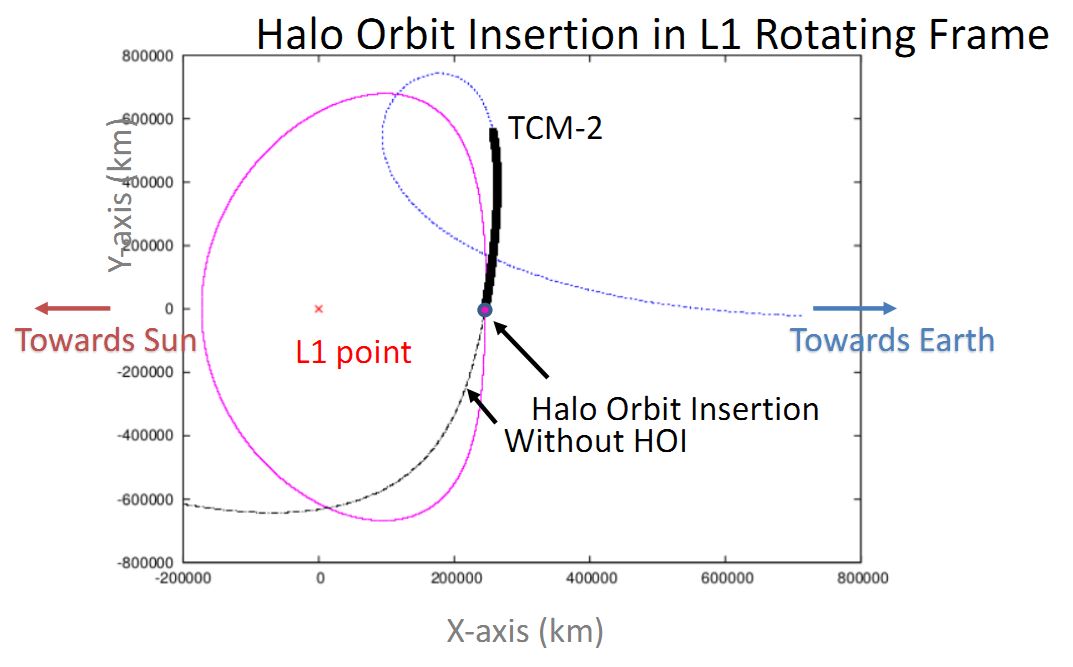Aditya-L1’s solar observatory spacecraft smoothly executed its Halo-Orbit Insertion (HOI) around 4:00 PM (IST) on January 6, 2024. The concluding step of this intricate process involved a brief activation of control engines to secure their position in the designated orbit.
Aditya-L1’s Orbit
The Aditya-L1 mission stands as an Indian solar observatory strategically positioned at Lagrangian point L1, devoted to the ceaseless study of the chromospheric and coronal dynamics of the sun.
Aditya-L1’s orbit is no ordinary path; it’s a periodic Halo orbit approximately 1.5 million km from Earth along the ever-shifting Sun-Earth line. This distinctive orbit completes one cycle in about 177.86 Earth days. This carefully chosen Halo orbit serves a strategic purpose, ensuring mission longevity of 5 years while minimizing the need for frequent station-keeping manoeuvres. This conserves fuel and guarantees an uninterrupted and clear view of the sun throughout the mission.
Opting for a halo orbit around the L1 point brings forth several advantages over a Low Earth Orbit (LEO):
- The halo orbit ensures a consistent Sun-spacecraft velocity alteration throughout its course, tailored explicitly for effective helioseismology.
- Placed outside Earth’s magnetosphere, Aditya-L1 is well-suited for the “in situ” sampling of the solar wind and particles, providing valuable data for solar research.
- This orbit guarantees an uninterrupted and unobstructed view of the sun, allowing for continuous observation. Additionally, it provides a constant line of sight to Earth, enabling seamless communication with ground stations.
Halo Orbit Insertion
Aditya-L1 seamlessly entered its Halo orbit by initiating the insertion process as it crossed the XZ plane within the Sun-Earth-L1 rotating system, equipped with the necessary orbital state.
This strategic manoeuvre was crucial in balancing the X and Z velocity components, aligning the spacecraft precisely with the required Y-velocity in the L1 rotating frame for the designated Halo orbit.
The specific coordinates for this orbital trajectory are Ax: 209200 km, Ay: 663200 km, and Az: 120000 km.
This orbital insertion, a pivotal mission phase, demanded precise navigation and control. The success of this complex process involved constant monitoring and fine-tuning of the spacecraft’s speed and position using onboard thrusters.

Aditya-L1, a collaborative effort of UR Rao Satellite Centre (URSC) and various ISRO centres, carries payloads developed by Indian scientific laboratories—IIA, IUCAA, and ISRO.
Launched aboard PSLV-C57 on September 2, 2023, from SDSC SHAR, the spacecraft initially entered an elliptical parking orbit (EPO) of 235.6 km by 19502.7 km. From there, Aditya-L1 embarked on an extraordinary journey toward the Sun-Earth-L1 Lagrange point, progressively increasing its orbital size with the help of the onboard propulsion system.
During the Earth orbit phase, five liquid engine burns (LEB) strategically raised the apogee of the EPO. The fifth burn, the trans-L1 injection (TL1I) manoeuvre, was crucial for attaining the desired trajectory towards the target L1 halo orbit.
A carefully devised strategy limited perigee passes to minimize incremental velocity addition (ΔV) and exposure to high radiation. TCM-1 on October 5, 2023, and TCM-2 on December 14, 2023, addressed errors during the TL1I phase, ensuring compliance with Halo orbit insertion condition parameters.

Following a cruise phase of approximately 110 days, the spacecraft reached its present condition before the targeted Halo-Orbit Insertion (HOI) on January 6, 2024. All payloads underwent rigorous testing during the pre-commissioning phase, confirming their satisfactory performance.
The graphic representation illustrates the Halo orbit insertion process in two dimensions. As Aditya-L1 moved from Earth toward the L1 point in the sun’s direction, TCM-1 and TCM-2 firings oriented the spacecraft towards the Halo Orbit.
The final firing at the marked red dot on January 6, 2024, precisely aligned the spaceship with the Halo Orbit, optimizing fuel consumption. Without the HOI manoeuvre, the spacecraft would have followed the alternative trajectory indicated.












Comments 1